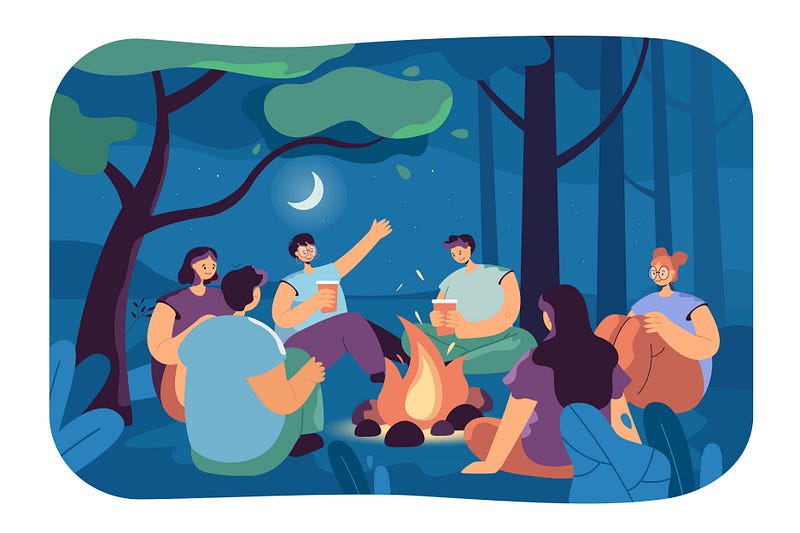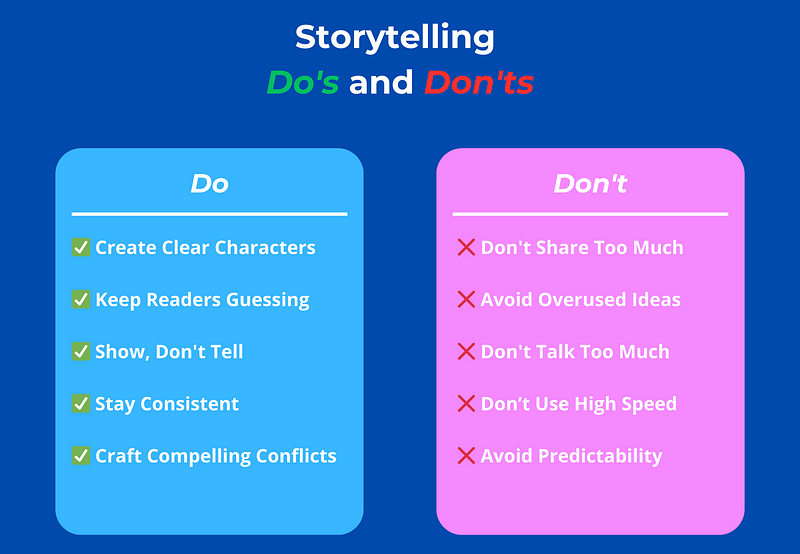3 Easy Steps to Create a Great Story and Improve Your Storytelling Skills
Learn How to Prepare, Improve, and Tell a Good Story People Will Love to Listen

In any sphere of life, we must be able to tell stories to people. And it’s not just stories with words; we should share emotions, tell exciting stuff, and engage people.
We use storytelling in various situations, such as job interviews, finding a partner, selling a product, teaching kids, setting rules, etc.
The primary skill we need to learn is to tell people what we want to share and what we want them to hear.
Any story has a purpose and a desirable action. Recently, I read a fantastic quote from a book.
The best thing a book can do for a person is to make him to act.
Thomas Carlyle
This book, The Personal MBA, has many more good quotes and statements we should consider. For those who are interested, I will leave the link below.
Let’s return to the storytelling topic and dive deep into this.
Storytelling Do’s and Don’t
I want to start this note from each step but with the picture. In the world of articles, people prefer to see words in images because it is much more interesting than seeing them on a plain white background.
So, with all my design skills, I’ve created the following piece using Canva.

I hope this image is pretty straightforward, but as I know that’s usually not enough, we will deep dive into each possible piece of advice I’ve found on the Internet to improve storytelling, become more interesting, and make people love to listen to our stories.
This article will contain three main points:
- how to prepare for storytelling
- how to make a story
- how to improve storytelling
Also, by the end of this article, I will leave some other valuable resources you may find interesting.
Step 1. Prepare Before Telling a Story
Before telling any story, we should prepare for this. I don’t mean that we should spend days on this, but usually, we need to understand the current situation and be sure if the story is good for the present moment or if we should keep it for another time.
Choose The Right Time and Place
Every day, we get into different places and situations. For example, you can be:
- in the office with your coworkers
- in the cafe with your friends
- at home with your family
- in the restaurant with your girlfriend
Each of these situations has a different context. Things like current news, weather, people around, and the mood of people participating in the conversation are essential.
Based on these items, we should pick the right story and tell it to people.
I will make a comparison in the world of articles. If you want to write a great article, you should be sure that it’s something people are interested in now.
If you write an article people are interested in, people will only read it. Also, if you pick the correct title, subtitle, and image, the story is different, and you won’t make other people interested in it because it’s boring.
Think About the Goal of Your Story
Any story you tell should have a specific goal. For example, you want to relax people in a group where almost nobody knows the other participants.
Or you want to help people solve their problems. Someone can get some disease or crash his car; you know a good solution and story that confirms this. In this context, it helps people, and they will be glad for your help.
Stories without any goals are nonsense. Even if you are telling just a funny story, it may have some goals like:
- entertaining
- teaching
- relaxing
Any story has a goal and purpose. We people created languages many years ago to simplify communication and interactions in the community.
That’s why you should learn that whenever you open your mouse, you should get to the point and make people understand why you are telling this.
Know Your Audience
Before telling the story, you also have to learn your audience.
All we learned in our childhood is that we shouldn’t tell our parents because they won’t get our goal of the story but will repurpose this and make it worse, destroying our story plan.
That’s why we had (and probably still have) separate stories for our friends and our relatives.
In the big world, this rule is the same. We should split our stories among different groups of people. It would help if you didn’t tell your boss the funny story about your students’ parties.
Think twice before telling a story because if you tell a story to the wrong group, people might find it weird, or worse, you might get dire consequences after it.
Step 2. Make a Story Interesting
After selecting the right story for your target audience in the right place, time, and context, you should make the storytelling process enjoyable and efficient for your audience.
If you tell the story interestingly, your audience gets bored quickly, and nobody will listen. What’s hidden in your story is only necessary if you present it correctly.
The next piece of advice will help you to make your story great.
Keep It Simple
Everything in your story should be understandable for everyone who listens to it. Don’t use complex words or formulas. Make short sentences with simple words.
If you want to say something difficult, make it as simple as you are trying to communicate this to the child.
Simplicity doesn’t mean that you tell a simple story. It means that you make it easy to understand. Could you keep it simple and easy to understand?
Be Clear and Concise
Use only a few sentences to describe the weather outside. Use several words if possible. It’s much better than you will do the whole lecture from this.
Recently, my friend told me a story about her acquaintance who told her a story where he gave a cup of water to his grandfather.
This story took 30–40 minutes! My friend told me that it was so dull and difficult to listen. The same sentences and simple actions we can describe in minutes. Don’t do like this. Don’t get your audience bored!
Another great example is whether you remember lessons in your school or university. I bet at least one teacher made such boring lectures that nobody from the students was listening.
These two examples’ lessons are to simplify your story, make it as short as possible, and stay clear and concise.
Be Aware of Your Body Language
Body language is one of the essential tools in the storytelling. If you use the wrong intonation and your body is locked, everybody will think about what’s wrong with you and why you are acting this way.
Another example of wrong body language is if you tell a sad story with a smile and look happy, people will think it’s too weird, and even people may feel angry with you.
Remember to synchronize your faces, gestures, and mood with your story context. You tell your story with your voice and whole body: eyes, hands, legs, etc.
Provoke an Emotional Reaction
If you have already applied all the steps above to your story, it’s excellent! Now you have a fantastic story! But only there is one thing.
Does your story send any emotion to your audience? We get big problems if the answer is no. The story should set the right mood and emotional state for all listeners.
If you are telling a story, create the following emotions in your audience using your body language, intonation, and words:
- sadness
- happiness
- joy
- delight
- laughter
You understand what your story is about and the main feeling that makes this story feel you should share with people around.
Make people feel what you feel, make them worried or relaxed, and put everything in your hands. And remember, without emotion, there won’t be any reaction or result.
Engage Your Audience
Your storytelling is not just a monologue. Of course, if you are not a speaker or something like that.
Engage your audience, make pauses, and ask people questions. What does someone think about some particular episode of your story?
It’s okay if someone inserts his story in yours, and you listen to it, too. Sometimes, people feel tired of endless listening and need more speaking opportunities. Give them this opportunity! And also get a rest for your tongue.
Put Yourself in Someone Else’s Shoes
When we tell a story about someone else, it’s an excellent skill to feel what the person felt.
Usually, people tell a story from their viewpoint that doesn’t share the real feelings and emotions of the main character.
It would help if you learned how to understand another person’s character and try to feel what he felt at that moment.
If you open the whole picture with your hero’s actions, emotions, and thoughts, you will become the hero in your story, and people will listen to this with the best possible concentration.
Choose a Clear Central Message
Every story should have an end. And your story should have this as well. Remember what the central message of your story is and work on it. Use all words, sentences, and chapters to get to the point.
Every story should have a purpose. And you should have it as well. Make people understand it, feel it, and get it!
Step 3. Improve Your Storytelling Skills
Nobody becomes a great storyteller in one day or with one story. We should practice consistently and work on our language.
The following tips will help you create a fantastic story and connection with your audience and those who listen to you.
Start Using Stories in Everyday Life
Every day, we get an opportunity to talk with people. Sometimes, we have only several minutes, and sometimes it might be hours.
Use each opportunity to talk with people. If someone is interested in listening to you, then tell them something. It’s good to have a great conversation. More awkward is to sit in the silence, right?
Observe Good Storytellers
Always look for teachers. You can improve any skill and do a much better job with teachers than without them. If you think you can do it alone, it’s okay.
But remember that great teachers can give you valuable feedback, the proper lessons, and sound samples. You will learn your faults and learn these lessons.
Find someone who is excellent at storytelling and listen to him.
Read, Listen, Watch, and Learn
After finding people, mentors, and teachers who may share knowledge with you, find more materials on the Internet and in real life:
- read books
- watch videos
- listen to podcasts
With the Internet, we have an excellent opportunity to learn more. Even on this Medium platform, you can get so much educational stuff that will teach you anything you’d like to.
“Being a student is easy. Learning requires actual work.” — William Crawford






